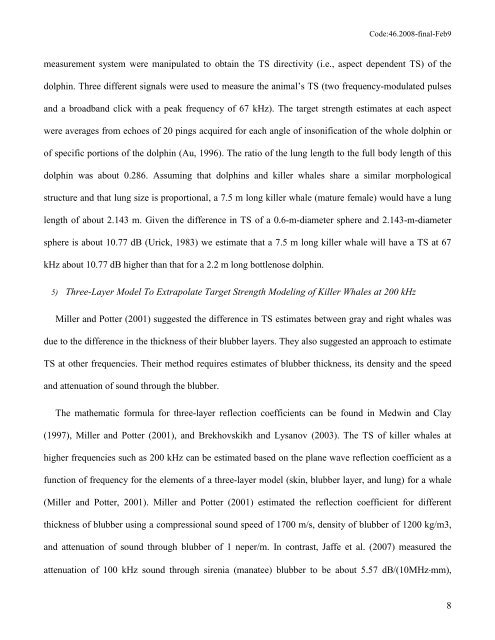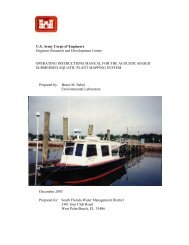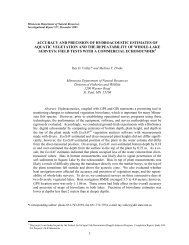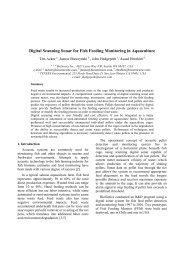Target Strength of Southern Resident Killer Whales ... - BioSonics, Inc
Target Strength of Southern Resident Killer Whales ... - BioSonics, Inc
Target Strength of Southern Resident Killer Whales ... - BioSonics, Inc
Create successful ePaper yourself
Turn your PDF publications into a flip-book with our unique Google optimized e-Paper software.
Code:46.2008-final-Feb9<br />
measurement system were manipulated to obtain the TS directivity (i.e., aspect dependent TS) <strong>of</strong> the<br />
dolphin. Three different signals were used to measure the animal’s TS (two frequency-modulated pulses<br />
and a broadband click with a peak frequency <strong>of</strong> 67 kHz). The target strength estimates at each aspect<br />
were averages from echoes <strong>of</strong> 20 pings acquired for each angle <strong>of</strong> insonification <strong>of</strong> the whole dolphin or<br />
<strong>of</strong> specific portions <strong>of</strong> the dolphin (Au, 1996). The ratio <strong>of</strong> the lung length to the full body length <strong>of</strong> this<br />
dolphin was about 0.286. Assuming that dolphins and killer whales share a similar morphological<br />
structure and that lung size is proportional, a 7.5 m long killer whale (mature female) would have a lung<br />
length <strong>of</strong> about 2.143 m. Given the difference in TS <strong>of</strong> a 0.6-m-diameter sphere and 2.143-m-diameter<br />
sphere is about 10.77 dB (Urick, 1983) we estimate that a 7.5 m long killer whale will have a TS at 67<br />
kHz about 10.77 dB higher than that for a 2.2 m long bottlenose dolphin.<br />
5) Three-Layer Model To Extrapolate <strong>Target</strong> <strong>Strength</strong> Modeling <strong>of</strong> <strong>Killer</strong> <strong>Whales</strong> at 200 kHz<br />
Miller and Potter (2001) suggested the difference in TS estimates between gray and right whales was<br />
due to the difference in the thickness <strong>of</strong> their blubber layers. They also suggested an approach to estimate<br />
TS at other frequencies. Their method requires estimates <strong>of</strong> blubber thickness, its density and the speed<br />
and attenuation <strong>of</strong> sound through the blubber.<br />
The mathematic formula for three-layer reflection coefficients can be found in Medwin and Clay<br />
(1997), Miller and Potter (2001), and Brekhovskikh and Lysanov (2003). The TS <strong>of</strong> killer whales at<br />
higher frequencies such as 200 kHz can be estimated based on the plane wave reflection coefficient as a<br />
function <strong>of</strong> frequency for the elements <strong>of</strong> a three-layer model (skin, blubber layer, and lung) for a whale<br />
(Miller and Potter, 2001). Miller and Potter (2001) estimated the reflection coefficient for different<br />
thickness <strong>of</strong> blubber using a compressional sound speed <strong>of</strong> 1700 m/s, density <strong>of</strong> blubber <strong>of</strong> 1200 kg/m3,<br />
and attenuation <strong>of</strong> sound through blubber <strong>of</strong> 1 neper/m. In contrast, Jaffe et al. (2007) measured the<br />
attenuation <strong>of</strong> 100 kHz sound through sirenia (manatee) blubber to be about 5.57 dB/(10MHzmm),<br />
8











